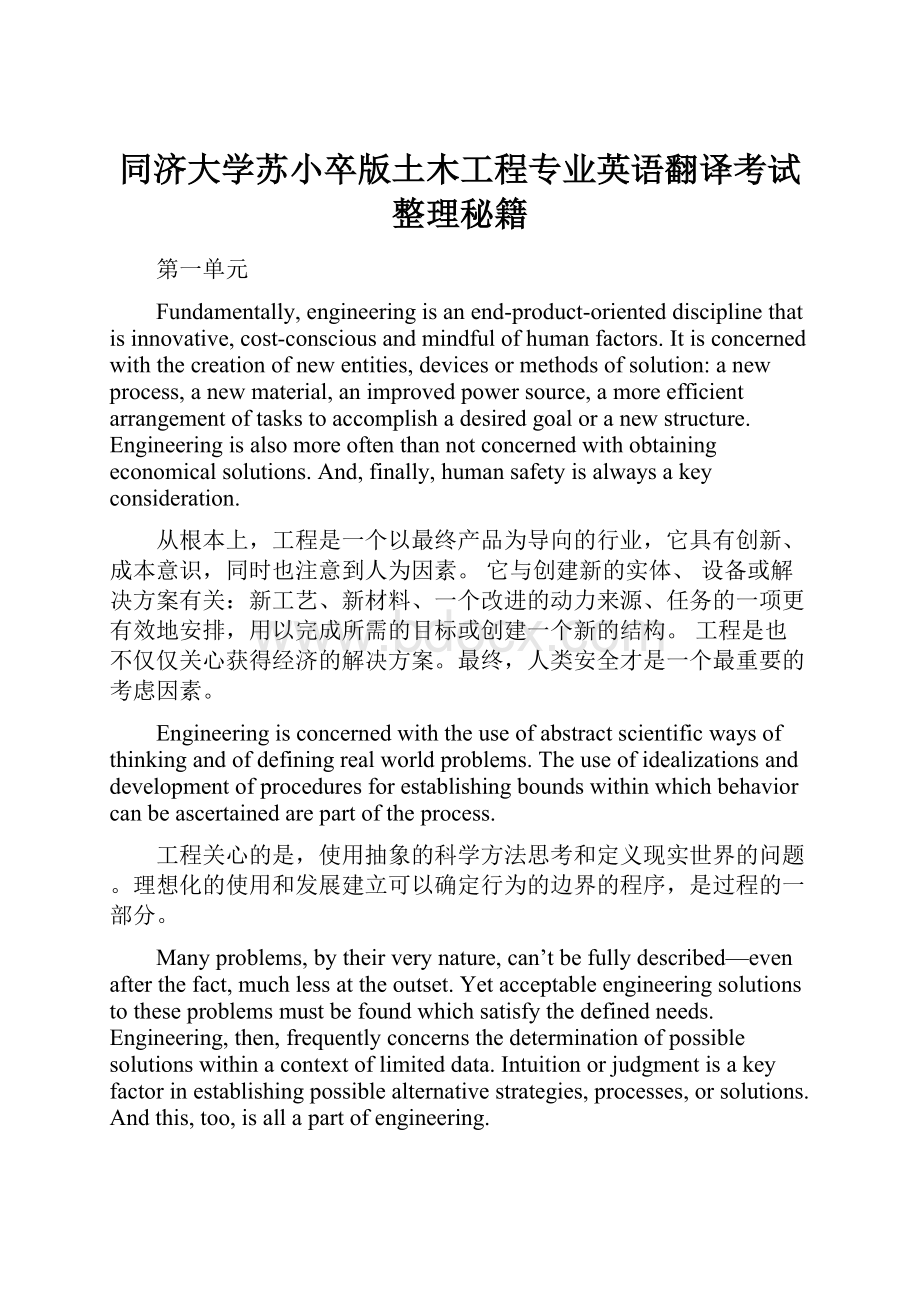同济大学苏小卒版土木工程专业英语翻译考试整理秘籍.docx
《同济大学苏小卒版土木工程专业英语翻译考试整理秘籍.docx》由会员分享,可在线阅读,更多相关《同济大学苏小卒版土木工程专业英语翻译考试整理秘籍.docx(81页珍藏版)》请在冰豆网上搜索。

同济大学苏小卒版土木工程专业英语翻译考试整理秘籍
第一单元
Fundamentally,engineeringisanend-product-orienteddisciplinethatisinnovative,cost-consciousandmindfulofhumanfactors.Itisconcernedwiththecreationofnewentities,devicesormethodsofsolution:
anewprocess,anewmaterial,animprovedpowersource,amoreefficientarrangementoftaskstoaccomplishadesiredgoaloranewstructure.Engineeringisalsomoreoftenthannotconcernedwithobtainingeconomicalsolutions.And,finally,humansafetyisalwaysakeyconsideration.
从根本上,工程是一个以最终产品为导向的行业,它具有创新、成本意识,同时也注意到人为因素。
它与创建新的实体、设备或解决方案有关:
新工艺、新材料、一个改进的动力来源、任务的一项更有效地安排,用以完成所需的目标或创建一个新的结构。
工程是也不仅仅关心获得经济的解决方案。
最终,人类安全才是一个最重要的考虑因素。
Engineeringisconcernedwiththeuseofabstractscientificwaysofthinkingandofdefiningrealworldproblems.Theuseofidealizationsanddevelopmentofproceduresforestablishingboundswithinwhichbehaviorcanbeascertainedarepartoftheprocess.
工程关心的是,使用抽象的科学方法思考和定义现实世界的问题。
理想化的使用和发展建立可以确定行为的边界的程序,是过程的一部分。
Manyproblems,bytheirverynature,can’tbefullydescribed—evenafterthefact,muchlessattheoutset.Yetacceptableengineeringsolutionstotheseproblemsmustbefoundwhichsatisfythedefinedneeds.Engineering,then,frequentlyconcernsthedeterminationofpossiblesolutionswithinacontextoflimiteddata.Intuitionorjudgmentisakeyfactorinestablishingpossiblealternativestrategies,processes,orsolutions.Andthis,too,isallapartofengineering.
很多的问题,就其本身的性质而言,不能完全被描述——即使这一事实,在其开始之前。
然而还必须找到对于这些问题可接受的工程解决方案,来满足预定的需求。
直觉或判断是建立可能的替代策略、流程或解决方案的关键因素。
。
而这也是工程的一部分。
Civilengineeringisoneofthemostdiversebranchesofengineering.Thecivilengineerplans,designs,constructs,andmaintainsalargevarietyofstructuresandfacilitiesforpublic,commercialandindustrialuse.Thesestructuresincluderesidential,office,andfactorybuildings;highways,railways,airports,tunnels,bridges,harbors,channels,andpipelines.Theyalsoincludemanyotherfacilitiesthatareapartofthetransportationsystemsofmostcountries,aswellassewageandwastedisposalsystemsthataddtoourconvenienceandsafeguardourhealth.
土木工程是工程的最多样化的分支机构之一。
土木工程师计划、设计、施工,和维护大量的结构和公共、商业和工业使用的设施。
这些结构包括住宅,办公室和工厂大厦;公路、铁路、机场、隧道、桥梁、港口、渠道和管道。
在其他大多数的国家它们还包括运输系统许多其他设施,以及将为我们的生活带来便利的和维护我们的健康污水及废物处理系统。
Theterm“civilengineer”didnotcomeintouseuntilabout1750,whenJohnSmeaton,thebuilderoffamousEddystonelighthousenearPlymouth,England,issaidtohavebeguncallinghimselfa“civilengineer”todistinguishhimselffromthemilitaryengineersofhistime.However,theprofessionisasoldascivilization.
直到大约1750年,人们才开始使用“土木工程师”这一术语。
约翰.斯密顿在英格兰普利茅斯附近,建造了著名的埃迪斯通灯塔的建造师,开始自称为“土木工程师"来将自己与当时的军事工程师区分开。
然而,土木工程这个职业却像文明一样古老。
InancientEgyptthesimplestmechanicalprinciplesanddeviceswereusedtoconstructmanytemplesandpyramidsthatarestillstanding,includingthegreatpyramidatGizaandthetempleofAmon-RaatKarnak.Thegreatpyramid,481feet(146.6meters)high,ismadeof2.25millionstoneblockshavinganaverageweightofmorethan1.5tons(1.4metrictons).Greatnumbersofmenwereusedintheconstructionofsuchmonuments.TheEgyptiansalsomadeobelisksbycuttinghugeblocksofstone,someweighingasmuchas1000tons(900metrictons).Cuttingtoolsofhardbronzewereused.
古埃及人用最简单的机械原理和装置建造了许多至今仍矗立的庙宇和金字塔,包括吉萨大金字塔和在卡纳克的Amon-Ra的寺庙。
这个大金字塔,481英尺(146.6米)高,由2250000个石块组成,石块的平均重量超过1.5吨(1.4吨)。
建造如此的纪念性建筑使用了大量的人力。
埃及人也作了一些重达1000吨(900吨)的石头的大块切割的方尖塔。
硬青铜的切削刀具在其中使用到了。
TheEgyptiansbuiltcausewaysandroadsfortransportingstonefromthequarriestotheNile.ThelargeblocksofstonethatwereerectedbytheEgyptiansweremovedbyusinglevers,inclinedplanes,rollers,andsledges.
为了从采石场向尼罗河运输石材埃及人建造了长堤和道路。
由埃及人竖设的大块石头通过使用拉杆、斜平面、滚子和雪橇来移动。
TheEgyptianswereprimarilyinterestedintheknow-howofconstruction;Theyhadverylittleinterestinwhy-forofuse.Incontrast,theGreeksmadegreatstridesinintroducingtheoryintoengineeringproblemsduringthe6thto3rdcenturiesB.C.Theydevelopedanabstractknowledgeoflines,angles,surfaces,andsolidsratherthanreferringtospecificobjects.ThegeometricbaseforGreekbuildingconstructionincludedfiguressuchasthesquare,rectangle,andtriangle.
埃及人主要对如何建造感兴趣;他们对为什么这么使用没有什么太多的兴趣。
相反,在公元前六世纪到公元前三世纪希腊人取得了巨大的进步于工程理论的推广。
他们发展了线、角度、面,和实体的抽象的知识,而不是与特定的对象产生联系。
希腊建筑施工的几何基础包括数字如正方形、矩形和三角形。
TheGreekarchitektonwasusuallythedesigner,aswellasthebuilder,ofarchitecturalandengineeringmasterpieces.Hewasanarchitectandengineer.Craftsmen,masons,andsculptorsworkedunderhissupervision.IntheclassicalperiodofGreeceallimportantbuildingswerebuiltoflimestoneormarble;theParthenon,forexample,wasbuiltofmarble.
希腊建筑师通常是建筑工程杰作的设计师同时也是建造师。
他既是一个建筑师也是工程师。
工匠、石匠和雕塑家在他的监督下工作。
在希腊古典时期所有重要建筑物是由石灰石或大理石建造的;以帕台农神庙为例,由大理石建成的。
UNIT3
Theprincipalconstructionmaterialsofearliertimeswerewoodandmasonry-brick,stone,ortile,andsimilarmaterials.Thecoursesorlayers(砖层)wereboundtogetherwithmortarorbitumen,atarlikesubstance,orsomeotherbindingagent.TheGreeksandRomanssometimesusedironrodsorclampstostrengthentheirbuilding.ThecolumnsoftheParthenoninAthens(雅典的帕台农神庙),forexample,haveholesdrilled(钻孔)inthemforironbarsthathavenowrustedaway(锈蚀殆尽).TheRomansalsousedanaturalcementcalledpozzolana,madefromvolcanicash,thatbecameashardasstoneunderwater.
早期主要的建筑材料是木材和砌体,如砖、石、瓦以及类似的材料。
砖层之间通过砂浆、沥青(一种焦油状的物质)或其他一些粘合剂粘合在一起。
希腊人和罗马人有时用铁条或夹子来加固他们的房屋。
例如,雅典的帕台农神庙柱子中曾钻孔以便加入铁条,如今都已锈蚀殆尽。
罗马人也用称作白榴火山灰的天然水泥,它用火山灰制作,在水中会变得与石头一样坚硬。
Bothsteelandcement,thetwomostimportantconstructionmaterialsofmoderntimes,wereintroduced(推广)inthenineteenthcentury.Steel,basicallyanalloyofiron(铁合金)andasmallamountofcarbon,hadbeenmadeuptothattime(到那个时候)byalaborious(繁复的)processthatrestrictedittosuchspecialusesasswordblades(刀刃).AftertheinventionoftheBessemerprocess(贝塞麦炼钢法)in1856,steelwasavailableinlargequantitiesatlowprices.Theenormousadvantageofsteelisitstensilestrength;thatis,itdoesnotloseitsstrengthwhenitisunderacalculateddegree(适当的)oftension,aforcewhich,aswehaveseen,tendsto(往往)pullapartmanymaterials.Newalloyshavefurtherincreasedthestrengthofsteelandeliminatedsomeofitsproblems,suchasfatigue,whichisatendencyforittoweakenasaresultofcontinualchangesinstress(连续的应力变化).
作为现代两种最重要的建筑材料,钢材与水泥在十九世纪得到了推广。
直到那个时候,钢材才通过繁复的过程制造出来,基本上是铁合金,并含有少量的碳,因而被限制在一些特殊的用途如刀刃。
在1856年发明了贝塞麦炼钢法后,钢材才得以大量低价获得。
钢材巨大的优势即是它的抗拉强度,也就是当它在适当的拉力下不会失去强度,正如我们所看到的,该力往往能够将很多材料拉开。
新的合金进一步提高了钢材的强度,并消除了一些缺点,如疲劳,即在连续的应力变化下导致强度减弱的趋势。
Moderncement,calledPortlandcement,wasinventedin1824.Itisamixtureoflimestone(石灰石)andclay,whichisheatedandthengroundintoapowder(磨成粉末).Itismixedatorneartheconstructionsite(施工现场)withsand,aggregate(smallstones,crushedrock,orgravel),andwatertomakeconcrete.Differentproportionsoftheingredients(配料)produceconcretewithdifferentstrengthandweight.Concreteisveryversatile;itcanbepoured,pumped,orevensprayedinto(喷射成)allkindsofshapes.Andwhereassteelhasgreattensilestrength,concretehasgreatstrengthundercompression.Thus,thetwosubstancescomplementeachother(互补).
现代水泥发明于1824年,称为波特兰水泥。
它是石灰石和粘土的混合物,加热后磨成粉末。
在或靠近施工现场,将水泥与砂、骨料(小石头、压碎的岩石或砾石)、水混合而制成混凝土。
不同比例的配料会制造出不同强度和重量的混凝土。
混凝土的用途很多,可以浇筑、泵送甚至喷射成各种形状。
混凝土具有很大的抗压强度,而钢材具有很大的抗拉强度。
这样,两种材料可以互补。
Theyalsocomplementeachotherinanotherway:
theyhavealmostthesamerateofcontractionandexpansion.Theythereforecanworktogetherinsituationswhere(在…情况下)bothcompressionandtensionarefactors(主要因素).Steelrods(钢筋)areembeddedin(埋入)concretetomakereinforcedconcreteinconcretebeamsorstructureswheretensionwilldevelop(出现).Concreteandsteelalsoformsuchastrongbond-theforcethatunites(粘合)them-thatthesteelcannotslip(滑移)withtheconcrete.Still(还有)anotheradvantageisthatsteeldoesnotrustinconcrete.Acid(酸)corrodessteel,whereasconcretehasanalkalinechemicalreaction,theoppositeofacid.
它们也以另外一种方式互补:
它们几乎有相同的收缩率和膨胀率。
因此,它们在拉、压为主要因素时能共同工作。
在出现拉力的混凝土梁或结构中,将钢筋埋入混凝土而成钢筋混凝土。
混凝土与钢筋形成如此强大的结合力——这个力将它们粘合在一起——以致于钢筋在混凝土中不会滑移。
还有另一个优势是钢筋在混凝土中不会锈蚀。
酸能腐蚀钢筋,而混凝土会发生碱性的化学反应,与酸相反。
Theadoptionofstructuralsteelandreinforcedconcretecausedmajorchangesintraditionalconstructionpractices(施工作业).Itwasnolongernecessarytousethickwallsofstoneorbrickformultistorybuildings,anditbecamemuchsimplertobuildfire-resistantfloors(防火地面).Boththesechangesservedto(有利于)reducethecostofconstruction.Italsobecamepossibletoerect(建造)buildingswithgreaterheightsandlongerspans.
结构钢与钢筋混凝土的采用使传统的施工作业发生了明显的变化。
对多层建筑,再也没必要采用厚的石墙或砖墙,且施工防火地面变为容易得多。
这些变化有利于降低建筑的成本。
它也使建造高度更高和跨度更大的建筑物成为可能。
Sincetheweightofmodernstructuresiscarried(承受)bythesteelorconcreteframe,thewallsdonotsupportthebuilding.Theyhavebecomecurtainwalls,whichkeepouttheweatherandletinlight.Intheearliersteelorconcreteframebuilding,thecurtainwallsweregenerallymadeofmasonry;theyhadthesolidlookofbearingwalls(承重墙).Today,however,curtainwallsareoftenmadeoflightweightmaterialssuchasglass,aluminum,orplastic,invariouscombinations.
由于现代结构的重量由钢或混凝土框架承受,墙体不再支承建筑物。
它们成为幕墙,将日晒风吹雨打阻挡在外,而让光线进入。
在较早的钢或混凝土框架建筑中,幕墙一般由砌体构成;它们具有承重墙的结实外观。
但是今天,幕墙通常由轻质材料组成,如玻璃、铝或塑料,并形成不同的组合。
Anotheradvanceinsteelconstruction(结构)isthemethodoffasteningtogether(连在一起)thebeams.Formanyyearsthestandardmethodwasriveting.Arivetisaboltwithaheadthatlookslikeabluntscrew(圆头螺丝钉)withoutthreads(螺纹).Itisheated,placedinholesthroughthepiecesofsteel(钢构件),andasecondheadisformedattheotherendbyhammering(锤击)ittoholditinplace(固定就位).Rivetinghasnowl